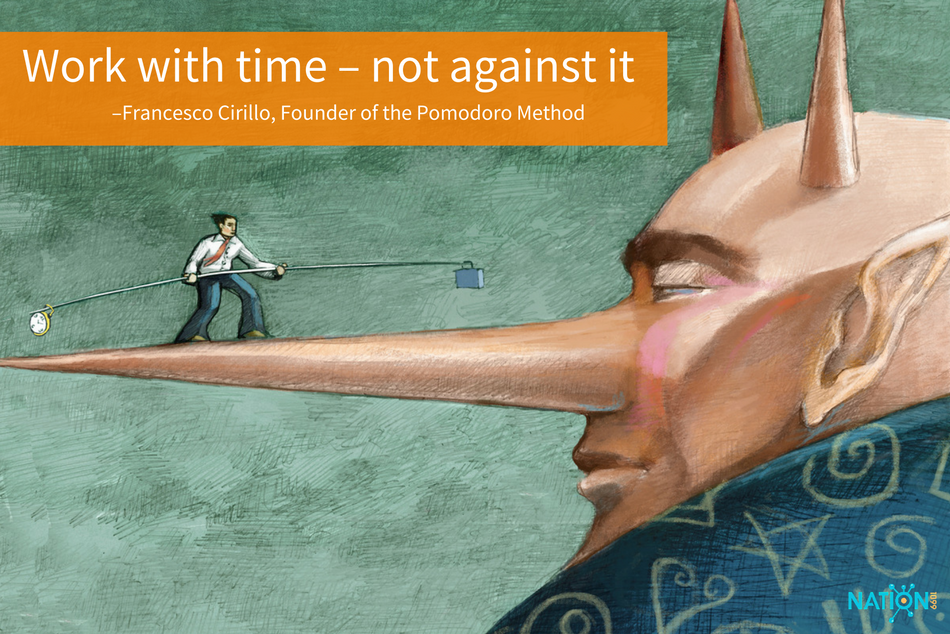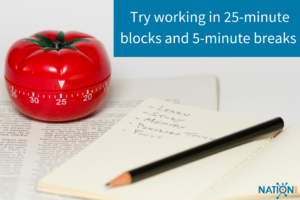Time — the eternal arch-nemesis of the independent — or so it often seems.
2016 was easily my most productive year to date — I took on a lot of new freelance work, I toured the country and the world multiple times, I developed many meaningful new relationships, and yet, I still wasted A LOT of time — time that could have made me, my happiness, and my talents that much better. To say the least, I have some healthy room for improvement, and I have a feeling you might as well.
Personal freedom is a huge benefit of the freelance and consulting lifestyles, but it can also be a major liability where time management is concerned. Put a nebulous schedule on top of this, and healthy work-life balance goes flying out the window.
As Nation1099’s vision statement outlines, having success as a solo means we want our readers to have the resources they need to grow their businesses and live a good life. We often say, “Jobs are for working, but gigging is for living.”
In this guide I’ll explore the most important work-life balance tips and time management techniques I’ve used in the last year towards achieving and maintaining the “good life” part. If I take my own advice, I’ll hopefully do a better job, myself, sticking to these in the next year!
Whether you are new to freelancing or consider yourself a seasoned professional, these best practices will restore sanity and ever-elusive leisure time to your scattered routine.
Track your time
Tracking your time is a lot like stepping on the scale — you know you should monitor your weight but fear seeing what the objective truth is (after eating two bags of pita chips and a full family-size vat of hummus).
In the case of the independent, time-tracking is just too essential to overlook. Time is money, the adage goes, and if you don’t know how long you’re spending on each client and task, you’re flying blind.
When you start tracking your time you will inevitably see that you spend far longer on most tasks and clients than you can justify. Don’t beat yourself up about this but use the wake-up call as motivation to do better.
Freelance personal finance writer Laura Shin also explains the crucial analytical aspect of time tracking in her Forbes article How A Freelancer Manages Her Time, Money, To-Do List And Despair. “I can get a rough sense of how much money I’m earning per hour from various gigs,” says Shin. “That per-hour “rate” also helps me see what places I should work for less, where I should try to work more or even where I might want to request a raise.”
There are many time management apps on the market and most are completely free or free with premium subscriptions for solos with many clients and team members.
Harvest is one of our favorites at Nation 1099 — as mentioned above, this app has a free version that is great for freelancers and a $12 per-month premium version for busy solopreneurs. The app is visually pleasing and integrates with many other popular planning apps like Trello. No reason not to give it a try!
Related Article: How to Not Screw Up: Four Essential Lifehacks for Freelancers
Make a consistent schedule for yourself
Want to know what one of the most mysterious and sophisticated time management techniques is? It isn’t a 15-step process –it’s making a consistent schedule you can actually stick to.
Ever meet a successful consultant who just gets up whenever and works on a completely arbitrary timeline? Yeah, me neither. You may be working from home but you still need to treat your work as if it’s a full-time job (or serious side hustle) to give yourself the organization you need to succeed.
Some people work better later in the day but, in general, making your mornings priority task time, or reserving them for high-will power items is the best way to go. You will be refreshed and ready to face your biggest challenges — and also less tempted to procrastinate than you will be later in the day.
Keep an up to date to-do list and triage!
Having some consistent places you outline your daily and weekly priorities will help you immensely.
Have you ever noticed how idiosyncratic to-do lists are? Everyone seems to have their own system. (I’d love to hear about yours in the comments section below!)
My system is to update a running list of important (and not so important) weekly to-dos on my notepad app on my laptop and also keep a sheet of paper nearby to organize daily “in-the-moment” tasks.
I’ve gotten in the habit of marking a few of these items with stars to identify the things I absolutely cannot go to sleep or leave the house before doing. The others, if need be, can wait.

Recognize your distractions and create “no distraction” times
To avoid your distraction triggers, be honest with yourself about the things that cloud your focus, and limit your involvement with them until break times. It can be helpful to make a list of all the things that distract you — social media, email, friends — and figure out which things are really getting in the way of you and your productivity. Try having a workday without each of these factors and see how you fare. The results may surprise you.
It took me a long time to realize I simply cannot work and listen to music. Unless I’m doing mindless tasks, I get too sucked in and drift from my duties at hand. Even for those mindless tasks (like updating spreadsheets or social following), I perform them at a slower and far less efficient pace. You probably have your own environmental factor that you don’t realize breaks your focus. Find it and cut it out!
Consider using the Pomodoro technique
And on the topic of distractions — there happens to be a very helpful system you can use to mitigate your self-destructive impulses to waste time! The Pomodoro Technique is one of the most popular time management techniques and with very good reason — it really works, and you don’t need the discipline of a monk to pull it off.
Invented by time management and productivity expert Francesco Cirillo, the Pomodoro Technique uses the simple principle of short bursts of distraction-free work punctuated by tiny breaks — think of it as interval training for your productivity.
All you need is a standard kitchen timer (or stopwatch app). Set your timer for 25 minutes and focus on nothing but a specific task for this time period. Cirillo’s kitchen timer happened to be shaped like a tomato — pomodoro in Italian — and now people who use this method call each unit of time a “pomodoro.”
Essentially, you’re making a deal with yourself about what you will do after the pomodoro. If you promise yourself that you can check email or scroll through Facebook later, you free yourself up to spend a period of truly concentrated attention on what you really need to do.
After the timer finishes, you take a five-minute break and refresh yourself for the next pomodoro. You will be surprised by how well this works.
“Work with time not against it”
This is one of the core principles of the Pomodoro technique and many of the other time management techniques we’ve discussed in this guide. The “race against time” is scary, high-stakes and leaves us feeling that we’re fighting a losing battle. The best way to address this cosmic force is to look critically at the time we have and admit to ourselves that we can use it better than we currently are.
Have an end-of-the-day review
As tempted as I usually am to completely check out of my work responsibilities past a certain time of day, I find that devoting about 15 minutes to preparation for the next day sets me up for much greater productivity over the course of the week.
I take this sliver of time to update my to-do list and organize myself for the next day’s work. I will often realize that I need to re-familiarize myself with some of my research sources before sitting down to write in the morning. I may also realize that — without this pause for review — I have no plan for the next day!
I can also use these 15 minutes to reflect on my productivity for the week. Was I as successful with my time-management as I would have liked? Where did I fall short and what can I do to better manage my distractions?
Be firm with clients about your availability
Ben R. Matthews, Director at digital marketing agency Montfort, advocates a common sense principle that too many solos ignore — instating a finite end to the work day.
“Not only will you be more focused in order to get finished on time, but you’ll also be able to relax in the evening and get a better night’s sleep,” Matthews rightly says in his personal blog.
While it may not be necessary in all cases, it generally helps to set some ground rules with your clients. For instance, every day after 5, or maybe 7 p.m., no client communications will be answered — unless there is a life-threatening emergency, at which point you’re probably not the person to call . . .
As is often the case with scope creep, most clients have no ill intentions when they “cross the line,” but they need to be made aware that the line exists and that they need to respect it. Work-life balance can be an “out of sight — out of mind” consideration for many clients. Sometimes you need to remind them of this.
Sell blocks of time to clients and bill upfront
Not necessarily a time management practice, but an important consideration that very much relates to time. Many of us need to do a better job blocking out our project hours and holding our clients to timely payments in a reliable way that lowers our stress. Obviously, worrying about when the next check will arrive, or how many unbillable hours we’re losing consulting with new leads are time-wasters none of us need.
Consultant and author of the Double Your Freelancing blog Brennan Dunn recommends freelancers switch their pay cycle to an upfront model and offers some useful advice on implementing this shift with clients.
“To transition to upfront billing, with new clients start letting them know that you sell blocks of hours upfront (or, ideally, weeks at a time), and that you only work once you’ve been paid,” says Dunn. “Just be sure to be clear that you’ll gladly refund any unused time should you part ways and you shouldn’t have an issue.”
Brennan also gave us some great insights about roadmapping and paid consultations with prospective clients in a recent interview. These are some very worthwhile changes to implement in the new year.
More on this subject: The Path To Higher Paying Clients – Insights From the Marketing Mentor
Map out your personal priorities
Now let’s shift gears for a moment. It’s great that you have your work slotted and sorted into your routine, but how do you make sure the things you really want to do are also accounted for?
One reason many solopreneurs burn out is because they eat, sleep, drink and breathe their businesses. There are certainly advantages to this kind of obsessive work ethic, but it also sets many of us up for an inevitable collapse somewhere down the line.
For most of us, while our career work might be our main priority, we need our schedules diversified and enriched with time spent in other disciplines and around friends and family. Having regular outlets for creativity and relaxation outside of your immediate work will keep you sane and ensure that genuine human connection does not wither away in your life.
Ask yourself this question: “What are the 5 things that matter most in my life?”
What are the things it would really hurt to live without? How do these things rank alongside each other? Are you neglecting some things or some people that should be higher priorities for you?
We can forget about our big picture items temporarily in the daily hustle, but the ache will grow over time. Make sure you leave yourself the time and energy to be a full person.
Schedule your physical activity
Unless you work from a standing desk, chances are high that you do a fair amount of sitting and that’s not good. Having some consistent times scheduled daily or several times a week to break a healthy sweat will relieve stress and offer a nice mental break from the sedentary routine.
I like to do this in two ways. I try to bang out a couple challenging items first thing in the morning and then take a mid-morning walk for about 25 minutes around the hilly trail I live near. It’s a nice reward for the high-brain-power activities I start with and it feels great to let my mind wander for a bit. I find that I’m much more creative later in the day if I build in this aerobic break.
I also schedule a more traditional “prison style” workout at the end of my own work day at around 6 p.m. I don’t always get to both but having these two go-to sessions in my schedule help me keep myself accountable for this important part of my well being.
When you leave work, leave the laptop.
One last word — your Macbook is not a small dog — it will not get separation anxiety and chew up your couch if you don’t let it into the bedroom. When that special time of day arrives, be good to yourself and leave the working world behind. Your sanity will thank you, and you won’t have that annoying “hot spot” on your mattress . . . ugh.
Over to you
Do you have any time management techniques or work-life balance tips in your routine that I might have missed? Do you have a special pathway to your Zen that you think would help other independents? Join the conversation in the comments section below and share your thoughts!

Ben Shanbrom is a freelance writer, musician, and copy editor who works with artists and clients within his native New Haven scene and well beyond (ask him about tracking drums in the studio where Europe recorded “The Final Countdown”). Ben is a tried and true “coffee rings on his notepad” freelancer, and wouldn’t have it any other way.












Greetings! I’ve been reading your web site for some time now and
finally got the bravery to go ahead and give you a shout out from Huffman Texas!
Just wanted to say keep up the great job!
Thanks Jim! Much appreciated.
Do you have any ideas for optimizing your time in the next year?
Cheers from New Haven, Connecticut!
-Ben
You’re right, time management is a very important thing for freelancers. I think many realize that, but getting out of the daily social media and email distractions is the real difficulty. I started tracking my worktime with a tool like harvest (http://www.clockodo.com) a while ago and see how i spent my time, but focussing on the important things is not easy. Perhaps I should try pomodoro.
Thanks for reading and weighing in, Jagdish. I’ve heard of Clockodo but never got around to trying it out. I’ll have to check it out! And definitely give the Pomodoro method a try — it really helps me overcome the daily will power hump.
I definitely agree about taking a few minutes at the end of the day to reflect, regroup, and plan out tomorrow. I always schedule out my day in 1-2 hour blocks, which I jot down on a pad of paper on my desk. That way I can assign my priorities while they’re still fresh in my mind, rather than waking up and wondering what I should start on first.
Scheduling out the day also helps me see when I’ve got waaay too many things on my to do list for the next day. (Which is literally every day.) It keeps me somewhat realistic!
Your note about to do lists made me laugh — yep, everybody’s got their own system.
I use Evernote, and wrote about my system here: https://medium.com/writers-on-writing/an-evernote-productivity-system-for-self-employed-creatives-5f82422ff789
I needed something digital since I’m on the go a lot — before I got the Evernote thing dialed in, I had Post-It notes *everywhere*.